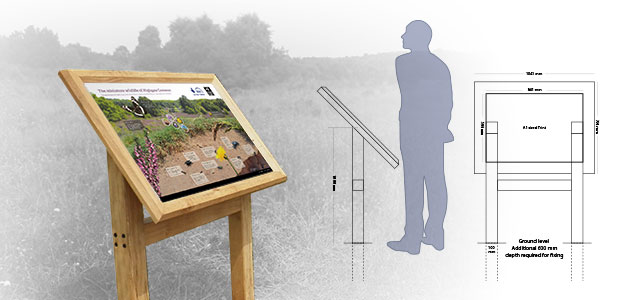Interpretation panels provide a fixed source of information that engage visitors with their immediate surroundings and – given the proper context – can impart an understanding of a much wider issue or philosophy.
The structures to which the interpretation panels are applied can be produced in a range of materials including oak, pressure-treated softwood and coated aluminium/steel. These signs can be totally bespoke in construction, but we have illustrated some of the more commonly utilised formats below.

What to avoid and when to apply

| Avoid too many messages Be brutal with your editing and remain true to your principles. |
Apply a clarity of message Write content that is intuitive and focusses on the key areas. |
| Avoid in-depth details Interpretations are generally viewed by a broad range of individuals who will have differing interests and priorities. |
Apply an engaging aesthetic Think about what it is that makes your environment unique and reflect the dynamic within the presentation. |
| Avoid a lack of context Make sure people know where they are in relation to any significant areas or landmarks. |
Apply a coherent plan of action Tell your audience about your aims and objectives for the area and keep them involved. |
Guidelines for an effective interpretation panel
Positioning
Make sure that your content is relevant to the positioning of the signage. Visitor entry zones would require signage that displays general content, this may be supported by satellite signage with more detailed information about specific areas or attractions.

Copy
For a large format panel we recommend no more than 300 words. Keep the language simple and the messages concise.
What type of content is going to appear on your panel?
- Educational; try and present your content in a way that encourages your audience to make discoveries through curiosity.
- Informational; make the content concise – avoid unnecessary embellishments and remove ambiguity.
- Conceptual; support your vision with compelling statements and inspiring proposals.
Maps
Many interpretation panels require the inclusion of a map. In the majority of instances where a map is necessary, it usually has a considerable impact on the look, feel and tone of the entire panel.
If you have a panel that needs a map consider:
- the general aesthetic; does the look and feel need to reflect a brand or predetermined philosophy/objective
- the level of detail; if there’s going to be a lot of information condense the text through editing or use iconography in tandem with a legend
- visually impaired visitors; keep primary text relatively large and do not rely on colours alone to define routes and areas
- establish orientation; make reference to the viewer’s current position and direction so that they can acquaint themselves with their surroundings
Photography
The requirement for photography is usually falls under three categories:
- Royalty free stock; widely available subject-based imagery that can be purchased on a modest budget
- Site specific; photography of the area that could be sourced by you or commissioned for use at your discretion
- Rights managed stock; provided under licence where the subject matter is restricted/exclusive and costed based on usage
Illustrations
Illustration and other forms of graphical representation may be necessary to convey a message, where photographs are not available or permissible. It is important consider the style of the material to ensure that it remains consistent – in tone and appearance – with the overall theme.
Digital interaction
Many digital devices such as mobile phones and tablets have inbuilt technology that allows seamless interaction with QR codes and/or electronic tags i.e. Near Field Communications (NFC) chips.
If your site is in an area that has sufficient mobile data coverage, or perhaps you could provide a WIFI signal for visitor use, you may well consider utilising a digital integration as a means to provide visitors with access to additional information.
This type of integration can greatly extend the longevity of a panel, diminishing the need for time sensitive information on the board itself and providing you with a medium that can be easily updated.
Previous projects
Crayfish Design has extensive experience of creating eye catching and informative interpretation boards. We will take the time to understand your objectives and your prospective audience, to devise a signage strategy that will present your vision with the maximum impact.

